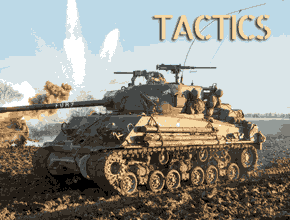The last operational Japanese tank hunter
 The Type 3 Ho-Ni III program started in 1942, as the Imperial Japanese Army experimented with early models of tank hunters, like the Ho-Ni I and II. These did not provide sufficient protection to their crews, with their partially open casemates. In early 1944, an order from the Army to Hitachi Ltd requested a new series, able to address theses issues. It was known, after being accepted for production, as the Ho-Ni III.
The Type 3 Ho-Ni III program started in 1942, as the Imperial Japanese Army experimented with early models of tank hunters, like the Ho-Ni I and II. These did not provide sufficient protection to their crews, with their partially open casemates. In early 1944, an order from the Army to Hitachi Ltd requested a new series, able to address theses issues. It was known, after being accepted for production, as the Ho-Ni III.
Design
General Layout
Hitachi's tank hunter was indeed the best of the series, based on the late Type 97 Chi-Ha Kai chassis. It fielded the 75 mm (2.95 in) Type 3 tank gun, derived from a rechambered Schneider M1927 85 mm (3.35 in) field gun. It had a very good muzzle velocity of 683 m/s (2,241 ft/s). This gun was later fitted on the Type 3 Chi-Nu medium tank. Around the Type 3 gun, the designers fitted a wide armored casemate, protruding from the sides, with a roof and two hatches, able to completely protect the gun crew, both from ground and aerial fire. The rear was closed with two armored doors. There was no provision for a secondary weapon, and no hull machine-gun. As the casemate was cramped, most rounds were stored below, in the hull, but it was a real improvement over past designs.The design of the Ho-Ni III reflected some of the improvements proposed by the Army Tank School around August 1941 for the prototype Type 1 7.5 cm self-propelled gun (Ho-Ni I vehicle) with the aim of turning it into a gun tank. Like the Type 1 7.5 cm self-propelled gun, the chassis was borrowed from the Type 97 Chi-Ha medium tank (Chi-Ha vehicle). While the original Type 1 7.5 cm self-propelled gun only had a simple mantlet protecting the front and sides, the Ho-Ni III featured a new, enclosed, heptagonal fighting compartment.
The Ho-Ni III adopted this enclosed fighting compartment because it was believed that a simple fighting compartment with armor only on the front and sides, like the Type 1 7.5 cm self-propelled gun, would be disadvantageous in anti-tank combat. The fighting compartment has been enlarged and protrudes slightly at both ends, giving it the appearance of a turret at first glance, but it is a fixed fighting compartment and does not rotate.
The armor on the front of the hull has been reinforced to 50 mm with additional armor, and the front of the fighting compartment has been replaced with a single 50 mm plate. In addition, the cradle shield protecting the gun carriage and recoil mechanism has been reinforced from 4 mm to 12 mm, and the secondary shield has also been reinforced from 12 mm to 25 mm.
Armament: Type 1 7.5cm
The main gun is the Type 3 7.5 cm tank gun (38 caliber, 75 mm gun), a further modification of the Type 90 field gun mounted on the Type 1 7.5 cm self-propelled gun. The gun's horizontal firing angle has been increased by 15 degrees to the left and right, and a direct aiming sight has been added. Another distinctive feature is that, similar to the firing method of field guns and Type 1 7.5 cm self-propelled guns, the gunner does not hold the firing device; instead, the gunner (who also serves as the radio operator.Some say there was a dedicated gunner on board, in which case the crew would be six) fires the gun by pulling the firing rope on the right side of the gun. If there was no gunner or if firing was not possible, the tank commander would pull the firing rope. For this reason, the firing rope was made longer than that of the Type 90 field gun. Aiming was done by the gunner observing the Type 1 sighting optical system, determining the direction and gun elevation, and firing was the responsibility of the gunner or tank commander, an unusual process. This prevented the commander from concentrating on search and command, and the gunner was unable to time the firing against moving targets.
On the other hand, the Type 1 7.5 cm self-propelled gun, which also fired by towing a rope, was tested by tank units around 1941 against moving targets using a tank-towed dummy target, and the tank units performing the tests achieved good results. As for secondary armament, unlike the Chi-Ha from which the vehicle was based, the Type 97 heavy machine gun mounted on the front left of the hull was removed. Instead, around the fighting compartment, gun ports and hatches with viewing slits were installed for firing submachine guns in preparation for close combat with infantry, and three Type 100 submachine guns were mounted inside the vehicle.
Armor-Penetrating Capacity: The Type 3 7.5 cm tank gun rounds penetration varies depended on the target armor plate, the year of testing, and other test conditions. Using standard Type 1 armor-piercing ammunition, the range was approximately 70 mm at 1,000 m and approximately 80 mm at 500 m. Using the "Special" tungsten-chromium steel ammunition, the range was approximately 85 mm at 1,000 m and approximately 100 mm at 500 m.
Due to rare metal rationing issues, the Type 1 armor-piercing ammunition, unlike the U.S. Army's armor-piercing ammunition, was made of high-carbon steel containing 1% chromium, 0.2% molybdenum, and small amounts of nickel. Instead, the Type 1 armor-piercing ammunition was made of steel containing 0.5–0.75% carbon, which was pressed, molded, and then heat-treated to harden and fill with explosives.
Additionally, an August 1945 U.S. War Department document listed the armor-piercing capabilities of the captured Type 90 field gun as follows: 1,500 yd (approximately 1,371.6 m) / 2.4 in (approximately 61 mm), 1,000 yd (approximately 914.4 m) / 2.8 in (approximately 71 mm), 750 yd (approximately 685.8 m) / 3.0 in (approximately 76 mm), 500 yd (approximately 457.2 m) / 3.3 in (approximately 84 mm), and 250 yd (approximately 228.6 m) / 2.4 in (approximately 89 mm) using Type 1 armor-piercing shells (equivalent to armor-piercing high-explosive shells) at a 90-degree impact angle.
Active service
The Ho-Ni III was to be used together with the Type 3 medium tank Chi-Nu (Chinu vehicle) during the decisive battle for the Japanese mainland, and was deployed to a gun tank company together with the Type 3 medium tank.
Due to a growing shortage of materials, a consequence of the ongoing bombing campaign and depredation caused by the US submarine fleet, very few of these tank hunters were built, and Hitachi records are not known with precision. Total production figures range between 31 and 41. These vehicles were a match for US tanks, like the M3 Grant, and even the M4 Shermans, but too few (if any) were allocated to units stationed in active sectors, like the Philippines or Okinawa. Most were kept on the Japanese Home Islands, waiting for the Allied invasion. Therefore, there is no record or clue of any tank-to-tank engagement of the Ho-Ni III.
Type 3 Ho-Ni III specifications |
|
| Dimensions | 5.52 x 2.29 x 2.39 m (18x7.6x7.10 ft) |
| Total weight, battle ready | 17 short tons |
| Crew | 4 (driver, commander, gunner, loader) |
| Propulsion | Mitsubishi air-cooled V12 diesel, 170 hp |
| Speed | 38 km/h (24 mph) |
| Armor | 12 to 25 mm (0.47-0.98 in) |
| Armament | 75 mm (2.95 in) Type 90 gun |
| Range | 200 km (160 miles) |
| Total production | 31 |
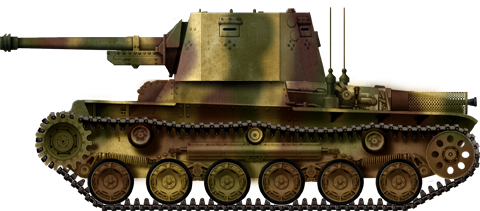
Type 3 Ho-Ni III, Japanese Home Islands, Honshu, late 1944.
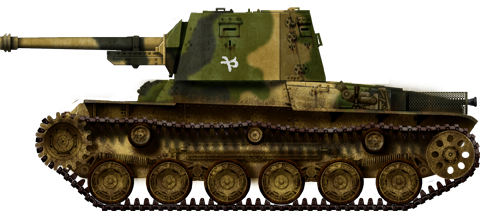
Type 3 Ho-Ni III, Home Islands, Kyushu, 1945.


Links
The Ho-Ni series on WWII Vehicles4 view drawing on The Blueprints
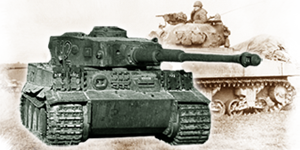
WW2 Tanks




























WW2 tanks posters
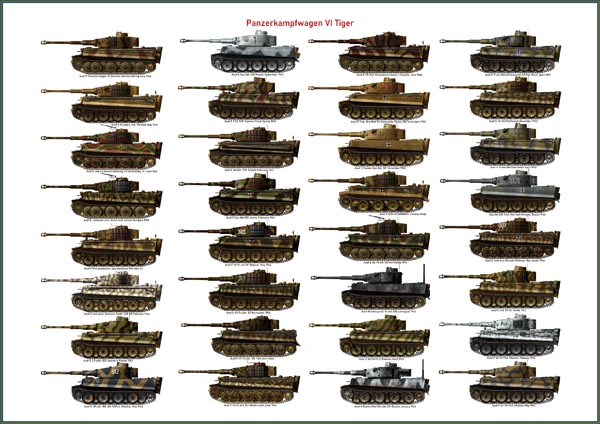
All Tiger tanks liveries.
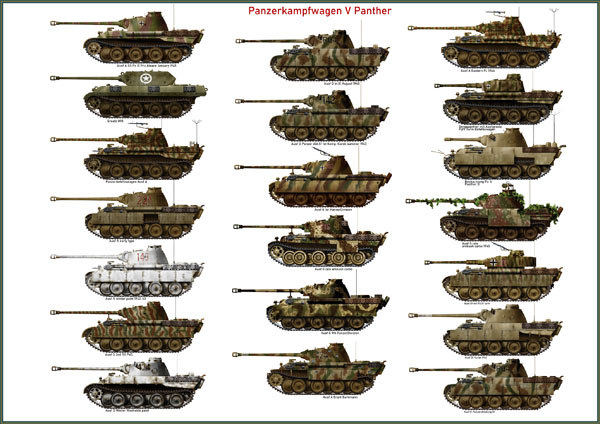
Panther liveries and variants
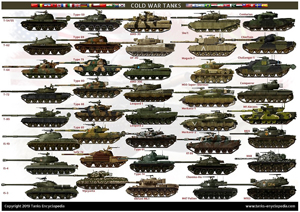
WW2 Armour - All tanks
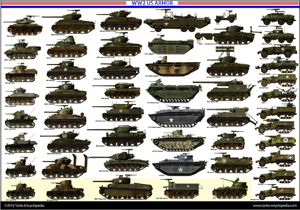










Tanks aces and single tanks series

Find more there
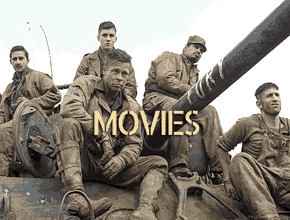
Museums, Movies, Books & Games
The Tanks and Armor in pop culture
Tanks and armored vehicles in general are only really grasped when seen first person: The mass, the scale, it's all there. Explore also the way tanks were covered in the movie industry, in books and in video games.Movies:
Best tanks movie on warhistoryonline.com
On imdb.com
On bestsimilar.com/
miltours.com
liveabout.com/
watchmojo.com
Video Games:
pcgamesn.com
historyhit.com
levvvel.com
vg247.com/best-tank-games
mmobomb.com/
alienwarearena.com
